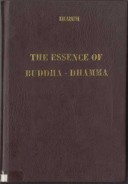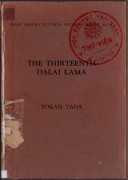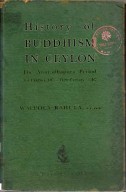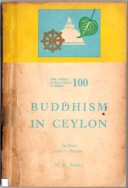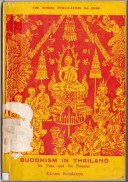Tìm Sách
Sách tiếng Anh-English >> The Essence of Buddha-Dhamma
Thông tin tra cứu
- Tên sách : The Essence of Buddha-Dhamma
- Tác giả : H. de S. KULARATNE
- Dịch giả :
- Ngôn ngữ : Anh
- Số trang : 144
- Nhà xuất bản : Gale Ceylon
- Năm xuất bản : 1955
- Phân loại : Sách tiếng Anh-English
- MCB : 12010000002961
- OPAC :
- Tóm tắt :
The Essence of Buddha-Dhamma
BY H .de S. KULARATNE J.P.U.M.
GALLE (Ceylon)
FOREWORD
I HOPE THIS BOOK WILL BENEFIT THE ENGLISH educated men and women, most of whom have not had the opportunity of studying the Tripitaka (the Buddhist Bible)either in the original Pali or in the form of translations. The Tripitaka consists of the Sutta, Vinaya and the Abhidhamma Pitakas. Pitaka literally means a basket. The Sutta Pitaka contains some of the Discourses of the Buddha addressed at various time and various places to the Sangha (Bhikkus or Monks) or the learned Brahamins, Kings, ministers and to many religious mendicants or ordinary laymen. These sermons are of general applicability. The Vinaya Pitaka deals mainly with the rules and regulations laid down for the good conduct of the monks, but the laymen too many read this Pitaka with profit. The Abhidhamma Pitaka is Buddhist Methaphysics,Psychology is a comparatively modern science and the knowledge about the mind so far gained by scientists is very small indeed compared with the perfect system of Buddhist psychology to be found in the Abhidhamma Pitaka. This teaching explains scientifically the Truths proclaimed by the Buddha. The Sutta Pitaka has five main Nikáyas and the last Nikáya, Khuddaka, has fifteen books. The Vinaya has five volumes and the Abhidhamma seven volumes.
CONTENTS
Foreword and Summary
Chapter 1 Paticca Samuppàda or Dependent Origination
Chapter 2 From Sorrow to Perfect Happiness in terms of Upanissaya Paccayà
Chapter 3 The path to Buddhist Sainthood Arahat or the Noble Eightfold Path
Chapter 4 Sammá Dithi or Righ Undertanding
Chapter 5 Paramis or Perfections
Chapter 6 The Singularity of Buddhism
Chapter 7 Practical Anatta
Chapter 8 Can Nibbana be Undertood?
Chapter 9 Washing Your Sins Away
Chapter 10 “ Whom Shall I Serve Today”
Chaptẹr 11 “ Existence and Creation” by Dr. D. G. de S. Kularatne
Chapter 12 The Tree of Wisdom
Chapter 13 The Buddha Smiles
 Facebook
Facebook
 Google
Google
 Google+
Google+
